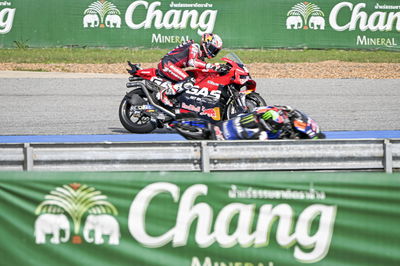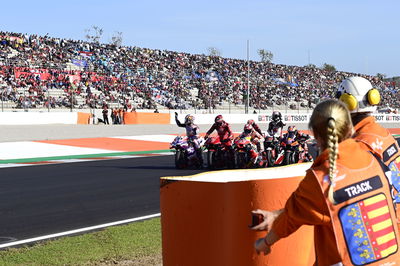Explained: Why Jorge Martin avoided a track limits penalty in Thai MotoGP sprint
Pramac rider risked penalty in sprint after track limits warning

Jorge Martin risked a penalty during the MotoGP Thai Grand Prix sprint when he was hit with a track limits warning, but escaped punishment.
Pramac rider Martin extended his championship lead over Francesco Bagnaia by two points to 22 after beating the factory Ducati rider to second in the sprint.
Immediately after overtaking Bagnaia at Turn 7 on lap seven of the sprint, Martin ran off the circuit on the exit of the corner and was subsequently hit with a track limits warning.
He ran off at the same point two tours later, with Bagnaia stating after the sprint that he counted four times in which Martin exceeded track limits and was expecting a penalty.
Martin did indeed run beyond track limits on at least four occasions during the 13-lap sprint, but only two were officially registered by the timekeepers.
The first on lap seven, after which he was given the warning, and a second on lap nine.
Martin later explained that he exceeded track limits twice at Turn 7 because: “I’m a bit on the limit in corner seven if I want to do the entry fast and go really soon onto the throttle, then I’m really on the limit on that exit.”
The Pramac rider said he knew he had “cards” to play with, which is why he didn’t try to muscle his GP24 from running beyond the kerbs.
Under the current regulations, if a rider exceeds track limits three times during a sprint then they will be hit with a long lap penalty. A first offence is what nets them a warning.
In the grand prix, a rider has to exceed track limits five times to gain a penalty, with a warning issued on the third infringement.
Why did Martin’s other track limits not matter?
On the opening lap, Martin ran off circuit at Turn 1 as he outbraked himself trying to go from first to third ahead of poleman Bagnaia.
On lap six, he did the same thing as he trailed Bagnaia a lap before overtaking the reigning world champion.
Track limits are only monitored at points painted green, where a significant advantage is deemed by the FIM stewards to be gained by exceeding the kerb.
Any area not painted green is not monitored by the timekeeping sensors that have been in use since the 2021 season.
The ‘Misano’ kerbs installed at Turn 1 where Martin exceeded track limits twice in the sprint are also designed to ensure riders lose time the higher they climb onto them.
While Bagnaia had expected a penalty (but conceded that he also may have been mistaken) and there has been discourse since the race over Martin’s exceeding of track limits, the simple fact is he did not break the rules.
Martin previously fell foul of a track limits warning at the Emilia Romagna sprint, when an early one distracted him and ultimately led to him losing the lead - and the win - to Bagnaia.
While he was not officially penalised in the Thailand sprint, the looming penalty for just one more mistake provided a nervous end to the race for Martin.
In the FIM stewards’ end-of-day report from Saturday in Thailand, it made no mention of Martin and track limits, with it clearly considered a non-issue.












